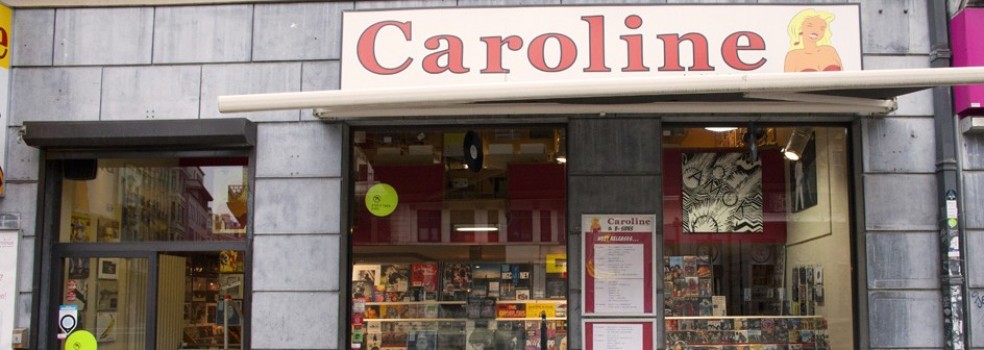Facing l’Ancienne Belgique nowadays on the opposite footpath on Boulevard Anspach, which has become a pedestrian zone in the middle of 2015, the Caroline Music store in Brussels has now a larger storefront and an enlarged retail area (on two floors), the result of its logical merger in January of 2013 with the Goupil-O-Phone (ex B-Side, vinyl oriented), at address 101 on the same boulevard. The store remains open seven days a week.
A completely independent record store since September 1977 (after the death of Elvis), which opened just after the punk wave hit Belgium, Caroline Music made its humble start on Rue Marché aux Herbes. The Marché aux Herbes location quickly became too cramped, and they moved to the centre city (1000 Brussels) where the music store would become, through 31 years (1981-2012), one of the most well known addresses in the Passage Saint-Honoré, just a couple of steps from the De Brouckère metro station. “We had the till, the counter, and the front door turnstile imported directly from England, which for a joke, we had set up in the opposite direction”, remembers Dédé, one of the key figures responsible for the store sign’s timeless cartoon design that’s existed since the beginning.
From the start, Caroline Music responded to all needs and desires connected to music —some that were even uncharted — from a mixed and passionate public who had trouble first hearing about those precious records and then finding them (first on vinyl, then on CD, and now returning again to vinyl). For the most part, they only came out of the anglophone rock scene — in the broadest sense of the term, from punk to the metal nebula, from soul to synth pop, not to mention folk, the unclassifiable discs, and even a bit of chanson française or world music. That was music in constant emulation and permanent (cyclical) turmoil but the discs that were released were, more or less, poorly distributed in Belgium or not at all. “Starting at the end of the seventies and for many years onward, we had to stock up at the wholesalers, mainly in Holland (Bertus) or in the UK. We would take the Ostende-Douvres ferry over once or twice a week, or we would even take a plane, and then come back with suitcases full of records that we had sometimes unwrapped in front of the first clients the next day at the shop,” recalls Dédé, almost moved by his brief explanation about the exceptional endurance of Caroline. “We’ve forever been looking for new trends, but we’ve never forgotten rock’s roots. At Caroline in 1997, you could find the Clash and Magma.” And Dédé shares a ton of memories, some more pleasant than others, to top it off. “Springsteen once came into the store, disguised. There was also an overdose in the shop and even the death of a music rep!”
“When it was still the heyday of CDs in the nineties, I remember that I had to look for a bit before I found something that caught my eye. It was definitely a place where fans that you would see at concerts would often come to. I’d go there three or four times a week,” Massimo recalled, a steady customer for years who then switched to the other side of the counter after finishing his studies in journalism and communication in 2008. The store employed four people at the time when it felt the effects of the CD format row more intense with each passing day. “When you’d find yourself again with a team of two and a half, you would think that no doubt you were drawing closer to the end of everything. And then vinyl returned to the scene, and with it, a certain return to the idea of the album as an object and the arrival of a (younger) public who never came in much before or not at all,” he added. Another part of the business that caused lines on Monday morning was the ticket counter, which no longer exists today, while on the first floor, a large selection of second-hand CDs, 33s, and film DVDs complement the vinyl offerings (and its large stock of limited edition and upscale pressings). “In hindsight, (Editor’s note: on Passage Saint-Honoré), I sometimes say to myself that we might have been able to create more of an interactive scene by hosting musicians more frequently (Mauro Pawlowski gave a small show there). At the same time, the loss of prestige of the gallery Passage Saint-Honoré happened right alongside the decline of the Caroline shop.”
The latest notable change on Boulevard Anspach is the neighborhood shift towards a pedestrian space that has changed the social order, bringing in more groups of passing international tourists, along with the usual locals who come by at the same time of day as well as a core group of faithful customers. “Amidst all of them, there are customers who’ve been coming for the past 20 years, each week on the same day at the same time, who know the people in the store by their first names, and among that group you find from time to time a (mostly) discrete musician who checks to see if his albums are on the shelves,” Dédé added. “What doesn’t change at Caroline Music is the conviviality and the quality advice. This little extra is what makes customers come to us rather than go to a big chain store, or on Amazon or eBay, or just feel satisfied in downloading an album. We offer a much smaller selection than before, but that’s because the number of copies has greatly diminished. I think I remember that it’s even Depeche Mode’s “Violator” which represents all-time best selling album for us.”
YH
